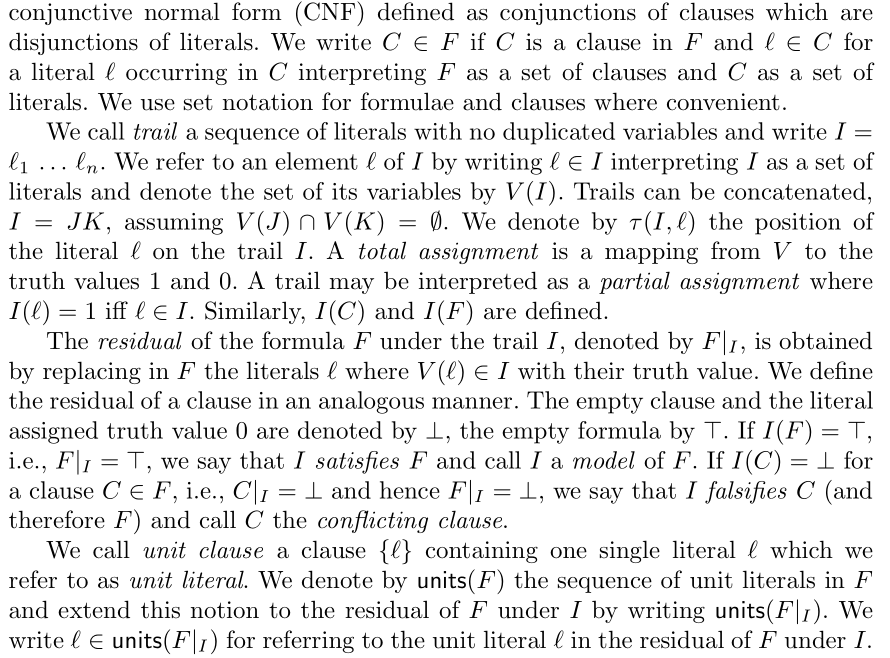|
SAT问题的通俗表述 Given a propositional formula, determining whether there exists a truth assignment for its propositional variables such that the formula evaluates to true is called the propositional Satisfiability problem, commonly abbreviated as SAT.
|
|
|
完备算法与不完备算法的表述 A solution method is said to be complete if it guarantees (given enough time) to find a solution if it exists, or prove lack of solution otherwise. Incomplete, or stochastic, methods, on the contrary, cannot guarantee finding the solution, although they may scale better than complete methods on some large satisfiable problems. |
|
|
sat已被证明是NP完全问题 Moreover, SAT carries considerable theoretical interest as the original NP-complete problem [A5, A8]. A5. S.A. Cook. The Complexity of Theorem-Proving Procedures. In Proceedings of Third Annual ACM Symposium on Theory of Computing, 1971. A8. M.R. Garey and D.S. Johnson. Computers and Intractability: A Guide to the Theory of NPCompleteness. W.H. Freeman and co., San Francisco, 1979. |
|
|
主要组件及其对应来源文献 Modern implementations of CDCL SAT solvers employ a lot of heuristics. Some of them can be considered baseline, such as:
Learnt Clause Minimization (LCM) [B9],
[B6] Moskewicz, M.W.; Madigan, C.F.; Zhao, Y.; Zhang, L.; Malik, S. Chaff: Engineering an efficient SAT solver. In Proceedings of the 38th Design Automation Conference (IEEE Cat. No.01CH37232), Las Vegas, NV, USA, 22 June 2001; pp. 530–535. [B7] Luby, M.; Sinclair, A.; Zuckerman, D. Optimal speedup of Las Vegas algorithms. Inf. Process. Lett. 1993, 47, 173–180. [B8] Audemard, G.; Simon, L. Predicting Learnt Clauses Quality in Modern SAT Solvers. In Proceedings of the 21st International Jont Conference on Artifical Intelligence, Pasadena, CA, USA, 11–17 July 2009; IJCAI’09. pp. 399–404. [B9] Luo, M.; Li, C.M.; Xiao, F.; Manyà, F.; Lü, Z. An Effective Learnt Clause Minimization Approach for CDCL SAT Solvers. In Proceedings of the Twenty-Sixth International Joint Conference on Artificial Intelligence, IJCAI-17, Melbourne, Australia 19–25 August 2017; pp. 703–711. [B13] Liang, J.H.; Ganesh, V.; Poupart, P.; Czarnecki, K. Exponential Recency Weighted Average Branching Heuristic for SAT Solvers. In Proceedings of the Thirtieth AAAI Conference on Artificial Intelligence, Phoenix, AZ, USA, 12–17 February 2016; AAAI’16. pp. 3434–3440. [B14] Liang, J.H.; Ganesh, V.; Poupart, P.; Czarnecki, K. Learning Rate Based Branching Heuristic for SAT Solvers. In Proceedings of the Theory and Applications of Satisfiability Testing—SAT 2016—19th International Conference, Bordeaux, France, 5–8 July 2016; Creignou, N., Berre, D.L., Eds.; Springer: Berlin/Heidelberg, Germany, 2016; Volume 9710, pp. 123–140. [B15] Zhang, X.; Cai, S. Relaxed Backtracking with Rephasing. In Proceedings of the SAT Competition 2020, Alghero, Italy, 3–10 July 2020; Solver and Benchmark Descriptions. University of Helsinki, Department of Computer Science: Helsinki, Finland, 2020; Volume B-2020-1, pp. 15–16. |
|
|
Non-Chronological Backtracking (NCB)、Conflict Analysis, 2 Watched-Literal, restarts, phase caching scheme, managing the learnt clause database, integrate inprocessing and sophisticated preprocessing techniques and VSIDS are still the most important ingredients of any CDCL implementation. Even if the theoretical reasons behind the practical success of SAT solvers are largely unclear,虽然是不明确的,许多模块作为组件ingredients are needed and must be incorporated in any SAT solver for 发挥CDCL的潜在能力。 |
|
|
SAT的应用场合及其来源文献 The task of computing the number of models of a propositional formula, also referred to as
[4] Fabrizio Biondi, Michael A. Enescu, Annelie Heuser, Axel Legay, Kuldeep S. Meel, and Jean
[11] Linus Feiten, Matthias Sauer, Tobias Schubert, Alexander Czutro, Eberhard B¨ohl, Ilia Polian, and Bernd Becker. #SAT-based vulnerability analysis of security components - A case study. In DFT, pages 49–54. IEEE Computer Society, 2012.
[15] Vladimir Klebanov, Norbert Manthey, and Christian J. Muise. SAT-based analysis and quantifi-
[19] Wei Li, Peter van Beek, and Pascal Poupart.
[24] Dan Roth. On the hardness of approximate reasoning. Artif. Intell., 82(1-2):273–302, 1996. [25] Tian Sang, Fahiem Bacchus, Paul Beame, Henry A. Kautz, and Toniann Pitassi. [26] Tian Sang, Paul Beame, and Henry A. Kautz. Heuristics for fast exact model counting. In SAT, [27] Tian Sang, Paul Beame, and Henry A. Kautz. Performing Bayesian inference by weighted model [28] Jo˜ao P. Marques Silva and Karem A. Sakallah. GRASP: A search algorithm for propositional [29] Marc Thurley. sharpSAT – counting models with advanced component caching and implicit BCP. [30] Peter van der Tak, Antonio Ramos, and Marijn Heule. Reusing the assignment trail in CDCL [31] Erik Peter Zawadzki, Andr´e Platzer, and Geoffrey J. Gordon. A generalization of SAT and #SAT [32] Christoph Zengler and Wolfgang K¨uchlin. Boolean quantifier elimination for automotive configu- |
|
|
标准符号表示——参见以下文献: [1]. Sibylle M¨ohle and Armin Biere. Backing backtracking. In SAT, volume 11628 of Lecture Notes in Computer Science, pages 250–266. Springer, 2019.
|
|






 浙公网安备 33010602011771号
浙公网安备 33010602011771号